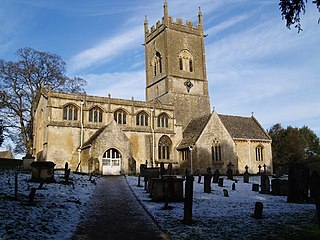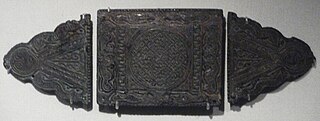
The Anglo-Saxons were a cultural group that inhabited much of what is now England in the Early Middle Ages, and spoke Old English. They traced their origins to settlers who came to Britain from mainland Europe in the 5th century. Although the details are not clear, their cultural identity developed out of the interaction of incoming groups of Germanic peoples, with the pre-existing Romano-British culture. Over time, most of the people of what is now southern, central, northern and eastern England came to identify as Anglo-Saxon and speak Old English. Danish and Norman invasions later changed the situation significantly, but their language and political structures are the direct predecessors of the medieval Kingdom of England, and the Middle English language. Although the modern English language owes somewhat less than 26% of its words to Old English, this includes the vast majority of words used in everyday speech.

Æthelflæd, Lady of the Mercians ruled Mercia in the English Midlands from 911 until her death. She was the eldest daughter of Alfred the Great, king of the Anglo-Saxon kingdom of Wessex, and his wife Ealhswith.

Æthelwulf was King of Wessex from 839 to 858. In 825, his father, King Ecgberht, defeated King Beornwulf of Mercia, ending a long Mercian dominance over Anglo-Saxon England south of the Humber. Ecgberht sent Æthelwulf with an army to Kent, where he expelled the Mercian sub-king and was himself appointed sub-king. After 830, Ecgberht maintained good relations with Mercia, and this was continued by Æthelwulf when he became king in 839, the first son to succeed his father as West Saxon king since 641.

The Kingdom of the South Saxons, today referred to as the Kingdom of Sussex, was one of the seven traditional kingdoms of the Heptarchy of Anglo-Saxon England. On the south coast of the island of Great Britain, it was originally a sixth-century Saxon colony and later an independent kingdom. The kingdom remains one of the least known of the Anglo-Saxon polities, with no surviving king-list, several local rulers and less centralisation than other Anglo-Saxon kingdoms. The South Saxons were ruled by the kings of Sussex until the country was annexed by Wessex, probably in 827, in the aftermath of the Battle of Ellendun.

Minster is an honorific title given to particular churches in England, most notably York Minster in Yorkshire, Westminster Abbey in London and Southwell Minster in Nottinghamshire.

Anglo-Saxon architecture was a period in the history of architecture in England from the mid-5th century until the Norman Conquest of 1066. Anglo-Saxon secular buildings in Britain were generally simple, constructed mainly using timber with thatch for roofing. No universally accepted example survives above ground. Generally preferring not to settle within the old Roman cities, the Anglo-Saxons built small towns near their centres of agriculture, at fords in rivers or sited to serve as ports. In each town, a main hall was in the centre, provided with a central hearth.

Sub-Roman Britain is the period of late antiquity in Great Britain between the end of Roman rule and the Anglo-Saxon settlement. The term was originally used to describe archaeological remains found in 5th- and 6th-century AD sites that hinted at the decay of locally made wares from a previous higher standard under the Roman Empire. It is now used to describe the period that commenced with the recall of Roman troops to Gaul by Constantine III in 407 and to have concluded with the Battle of Deorham in 577.
Nothhelm was a medieval Anglo-Saxon Archbishop of Canterbury. A correspondent of both Bede and Boniface, it was Nothhelm who gathered materials from Canterbury for Bede's historical works. After his appointment to the archbishopric in 735, he attended to ecclesiastical matters, including holding church councils. Although later antiquaries felt that Nothhelm was the author of a number of works, later research has shown them to be authored by others. After his death he was considered a saint.

The history of York, England, as a city dates to the beginning of the first millennium AD but archaeological evidence for the presence of people in the region of York dates back much further to between 8000 and 7000 BC. As York was a town in Roman times, its Celtic name is recorded in Roman sources ; after 400, Angles took over the area and adapted the name by folk etymology to Old English Eoforwīc or Eoforīc, which means "wild-boar town" or "rich in wild-boar". The Vikings, who took over the area later, in turn adapted the name by folk etymology to Norse Jórvík meaning "wild-boar bay", 'jór' being a contraction of the Old Norse word for wild boar, 'jǫfurr'. The modern Welsh name is Efrog.

Withington is a Cotswold village and civil parish in Gloucestershire, England, about 7 miles (11 km) southeast of Cheltenham and 8 miles (13 km) north of Cirencester. The River Coln runs through the village. The parish includes the hamlets of Hilcot, Foxcote and Cassey Compton. The parish population taken at the 2011 census was 532.

Wales in the early Middle Ages covers the time between the Roman departure from Wales c. 383 until the middle of the 11th century. In that time there was a gradual consolidation of power into increasingly hierarchical kingdoms. The end of the early Middle Ages was the time that the Welsh language transitioned from the Primitive Welsh spoken throughout the era into Old Welsh, and the time when the modern England–Wales border would take its near-final form, a line broadly followed by Offa's Dyke, a late eighth-century earthwork. Successful unification into something recognisable as a Welsh state would come in the next era under the descendants of Merfyn Frych.

Mucking is an archaeological site near the village of Mucking in southern Essex. The site contains remains dating from the Neolithic to the Middle Ages—a period of some 3,000 years—and the Bronze Age and Anglo-Saxon features are particularly notable.
Saint Materiana is a Welsh saint, patron of two churches in Cornwall and one in Wales. Alternative spellings are Madrun and Madryn. The name was corrupted to "Marcelliana" in medieval times. Another spelling of her name sometimes used is "Mertheriana" or "Merthiana", resembling the Welsh merthyr - "martyr".

The Anglo-Saxon settlement of Britain is the process which changed the language and culture of most of what became England from Romano-British to Germanic. The Germanic-speakers in Britain, themselves of diverse origins, eventually developed a common cultural identity as Anglo-Saxons. This process principally occurred from the mid-fifth to early seventh centuries, following the end of Roman rule in Britain around the year 410. The settlement was followed by the establishment of the Heptarchy, Anglo-Saxon kingdoms in the south and east of Britain, later followed by the rest of modern England, and the south-east of modern Scotland. The exact nature of this change is a topic of on-going research. Questions remain about the scale, timing and nature of the settlements, and also about what happened to the previous residents of what is now England.
The Beormingas were a tribe or clan in Anglo-Saxon England, whose territory possibly formed a regio or early administrative subdivision of the Kingdom of Mercia. The name literally means "Beorma's people" in Old English, and Beorma is likely to have been either the leader of the group during its settlement in Britain or a real or legendary tribal ancestor. The name of the tribe is recorded in the place name Birmingham, which means "home of the Beormingas".

St Oswald's Priory was founded by Æthelflæd, daughter of Alfred the Great, and her husband Æthelred, ealdorman of Mercia, in the late 880s or the 890s. It appears to have been an exact copy of the Old Minster, Winchester It is a Grade I listed building.
The minster hypothesis is a debated view that the organisation of the early Anglo-Saxon Christian church was based around minsters staffed by communities of clerics and providing spiritual services within a defined area.
Regiones or provinciae,(singular: provincia), also referred to by historians as small shires or early folk territories, were early territorial divisions of Anglo-Saxon England, referred to in sources such as Anglo-Saxon charters and the writings of Bede. They are likely to have originated in the years before 600, and most evidence for them occurs in sources from or about the 7th century.
The Limenwara or Limenware were a people of Anglo-Saxon England whose territory formed a regio or early administrative subdivision of the Kingdom of Kent. The name means "Limen-dwellers", with "Limen" being the name of the former eastern arm of the River Rother, which at that time entered the sea at Lympne.